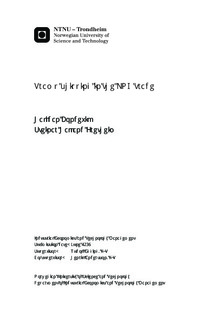| dc.contributor.advisor | Egging, Rudolf | nb_NO |
| dc.contributor.advisor | Andersson, Henrik | nb_NO |
| dc.contributor.author | Fretheim, Steinar Halland | nb_NO |
| dc.contributor.author | Bondevik, Halfdan | nb_NO |
| dc.date.accessioned | 2014-12-19T14:31:19Z | |
| dc.date.available | 2014-12-19T14:31:19Z | |
| dc.date.created | 2014-09-18 | nb_NO |
| dc.date.issued | 2014 | nb_NO |
| dc.identifier | 748305 | nb_NO |
| dc.identifier | ntnudaim:11018 | nb_NO |
| dc.identifier.uri | http://hdl.handle.net/11250/266981 | |
| dc.description.abstract | LNG is to an increasing extent traded through spot markets and short-term contracts. At the same time, gas production is growing and the number of importers and exporters of LNG is increasing. These trends lead to greater opportunities for actors who are looking into speculative trading of LNG. In this thesis, we develop two stochastic optimization models for buying, transporting and selling LNG in the spot market. We take the perspective of an actor that owns LNG vessels and does speculative trading. The objective is to maximize profit. This is done by making optimal movement and trade decisions. Income is generated by buying and selling LNG. Costs relate to operating the LNG vessel. The models make a trade-off between maximizing revenue and minimizing cost. The price processes in the ports are stochastic. We use scenarios to represent an approximation of the price development process. The models make use of a dynamic program to estimate the value of potential trade sequences. Two stochastic models are run in combination with the dynamic program in order to make movement and trade decisions. One is a mixed-integer program (MIP) that is run by commercial optimization software (Xpress-Mosel). The other is a heuristic written in Java. We present solutions for both deterministic and stochastic test instances. The stochastic solution takes uncertainty into consideration and presents the decisions that are best hedged against all outcomes of price development. Our main focus is on comparing the stochastic and deterministic versions of the two models, in order to identify the solution approach that best solves our problem. The stochastic versions are found to provide better solutions than the deterministic ones. This goes for both models. The heuristic solution outperforms the MIP when considering both profit, run time and stability. With minor adjustments the models can be used as real life decision tools. | nb_NO |
| dc.language | eng | nb_NO |
| dc.publisher | Institutt for industriell økonomi og teknologiledelse | nb_NO |
| dc.title | Tramp shipping in the LNG trade | nb_NO |
| dc.type | Master thesis | nb_NO |
| dc.source.pagenumber | 161 | nb_NO |
| dc.contributor.department | Norges teknisk-naturvitenskapelige universitet, Fakultet for samfunnsvitenskap og teknologiledelse, Institutt for industriell økonomi og teknologiledelse | nb_NO |

